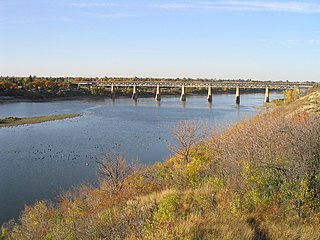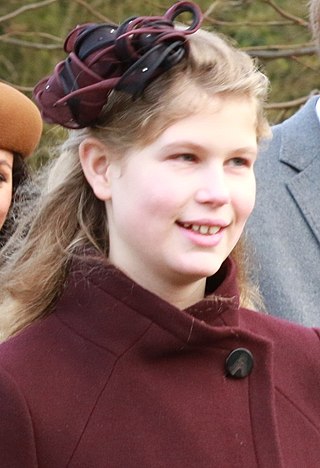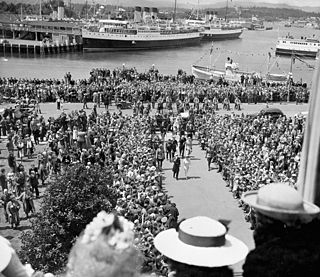
Manitoba is a province of Canada at the longitudinal centre of the country. It is Canada's fifth-most populous province, with a population of 1,342,153 as of 2021. Manitoba has a widely varied landscape, from arctic tundra and the Hudson Bay coastline in the north to dense boreal forest, large freshwater lakes, and prairie grassland in the central and southern regions.

The Trans-Canada Highway is a transcontinental federal–provincial highway system that travels through all ten provinces of Canada, from the Pacific Ocean on the west coast to the Atlantic Ocean on the east coast. The main route spans 7,476 km (4,645 mi) across the country, one of the longest routes of its type in the world. The highway system is recognizable by its distinctive white-on-green maple leaf route markers, although there are small variations in the markers in some provinces.

The Saskatchewan River is a major river in Canada. It stretches about 550 kilometres (340 mi) from where it is formed by the joining of the North Saskatchewan River and South Saskatchewan River just east of Prince Albert, Saskatchewan, to Lake Winnipeg. It flows roughly eastward across Saskatchewan and Manitoba to empty into Lake Winnipeg. Through its tributaries the North Saskatchewan and South Saskatchewan, its watershed encompasses much of the prairie regions of Canada, stretching westward to the Rocky Mountains in Alberta and north-western Montana in the United States.

Princess Louise, Duchess of Argyll was the sixth child and fourth daughter of Queen Victoria and Prince Albert.

Lady Louise Alice Elizabeth Mary Mountbatten-Windsor is the daughter of Prince Edward, Duke of Edinburgh, and Sophie, Duchess of Edinburgh. She is a granddaughter of Queen Elizabeth II, and the youngest niece of King Charles III. Born 8th in line to the British throne, she is now 16th.

Events from the year 1912 in Canada.

Events from the year 1846 in Canada.

Events from the year 1851 in Canada.
The orders, decorations, and medals of the Canadian provinces, in which each province of Canada has devised a system of orders and other awards to honour residents for actions or deeds that benefit their local community or province, are in turn subsumed within the Canadian honours system. Each province sets its own rules and criteria for eligibility and also for how each award is presented. Most of the awards allow for the recipients to wear their awards in public, and most grant the recipients the use of post-nominal letters after their names. Not all of the awards listed below are part of the Canadian honours system, thus some of them may not be worn or court mounted with awards that are part of the Canadian honours system.

David Laird, was a Canadian politician. He was born in New Glasgow, Prince Edward Island, into a Presbyterian family noted for its civic activism. His father Alexander had been a long time Reformer and Liberal MLA. David became a Liberal MLA for Belfast. He also established and edited The Patriot.
The Rural Municipality of Albert is a former rural municipality (RM) in the Canadian province of Manitoba. It was originally incorporated as a rural municipality on December 1, 1905. It ceased on January 1, 2015 as a result of its provincially mandated amalgamation with the RM of Arthur and the RM of Edward to form the Municipality of Two Borders.
The King's Printer is typically a bureau of the national, state, or provincial government responsible for producing official documents issued by the King-in-Council, Ministers of the Crown, or other departments. The position is defined by letters patent under the royal prerogative in various Commonwealth realms.

The history of post-confederation Canada began on July 1, 1867, when the British North American colonies of Canada, New Brunswick, and Nova Scotia were united to form a single Dominion within the British Empire. Upon Confederation, the United Province of Canada was immediately split into the provinces of Ontario and Quebec. The colonies of Prince Edward Island and British Columbia joined shortly after, and Canada acquired the vast expanse of the continent controlled by the Hudson's Bay Company, which was eventually divided into new territories and provinces. Canada evolved into a fully sovereign state by 1982.

By the arrangements of the Canadian federation, Canada's monarchy operates in Manitoba as the core of the province's Westminster-style parliamentary democracy. As such, the Crown within Manitoba's jurisdiction is referred to as the Crown in Right of Manitoba, His Majesty in Right of Manitoba, or the King in Right of Manitoba. The Constitution Act, 1867, however, leaves many royal duties in Manitoba specifically assigned to the sovereign's viceroy, the lieutenant governor of Manitoba, whose direct participation in governance is limited by the conventional stipulations of constitutional monarchy.

James Alexander Philip Theo Mountbatten-Windsor, Earl of Wessex is the younger child and son of Prince Edward, Duke of Edinburgh and Sophie, Duchess of Edinburgh. He is the youngest grandchild of Queen Elizabeth II and Prince Philip, Duke of Edinburgh, and the youngest nephew of King Charles III. At the time of his birth, he was 8th in line to the British throne. He is now 15th in line.
In Canada, a number of sites and structures are named for royal individuals, whether a member of the past French royal family, British royal family, or present Canadian royal family thus reflecting the country's status as a constitutional monarchy under the Canadian Crown. Those who married into the royal family are indicated by an asterisk (*). Charles Edward Stuart was a pretender to the British throne.
In 1945 the Geographical Names Board of Canada began a program to name previously unofficially named features after casualties from all three branches of the Canadian armed forces. With around 100,000 lakes, most without names, Manitoba has been an enthusiastic adopter of the program. In 1995 the project to commemorate the 4,000 Manitoba casualties from the Second World War by naming lakes, islands and bays after them was completed.

Royal tours of Canada by the Canadian royal family have been taking place since 1786—when the future King William IV became the first member of the royal family to visit Canada—and continue into the 21st century, either as an official tour, a working tour, a vacation, or a period of military service by a member of the royal family. In 1939, King George VI became the first reigning monarch to tour the country.
Cornish Canadians are Canadians of Cornish descent, including those who were born in Cornwall. The number of Canadian citizens of Cornish descent cannot be determined through census statistics, though speculative estimates place the population as high as 20,000.












